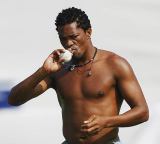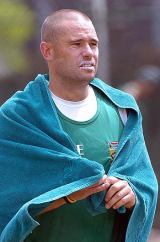Speed trial
Down South Africa way there's only ever been one kind of bowling, and it's not the sort Indian batsmen have traditionally fancied. Telford Vice looks ahead to India's big tour of the season
Telford Vice
18-Nov-2006
Down South Africa way there's only ever been one kind of bowling, and it's not the sort Indian batsmen have traditionally fancied. Telford Vice looks ahead to India's big tour of the season
|
|

|
Batsman or bowler?" It's a question that is asked wherever cricket is played, particularly early in the season at club and schools nets and matches. In South Africa, if the answer is "bowler" or "allrounder", the case is closed. No one thinks to ask what style of bowler, and no bowler describes himself as anything other than fast. An answer of "keeper" is often met with a nod of resignation: they're a necessary evil, wicketkeepers. But they're far more useful than that other lot: spinners - at best an irrelevance, at worst an unnecessary evil.
South African spinners are either misguided schoolboys who are eventually persuaded to abandon the art by the sheer ignorance of their captains and coaches, or they are retreads who failed the grade as seamers. Thus, to be a spinner in South Africa is to be a hopelessly romantic innocent or a cynical has-been. This is a caricature, but it is accurately drawn from the South African reality. Of course there have always been exceptions, born spinners, like... well, no one, actually.
Against that background is it any wonder that a disproportionately large chunk of wickets taken by South Africa in international cricket belong to fast bowlers? This has been even more evident since the country's return to international cricket. Somewhere between the start of isolation in 1970 and readmittance in 1991, South Africans put almost all of their faith in fast bowlers. And they have been proved right. Allan Donald bowled his way to the top of the game in the 1990s. He was followed to the summit by Shaun Pollock, and then by Makhaya Ntini.
Some of those in the current crop will face a searching enquiry this season: are they worthy of the mantle bequeathed them by legends like Peter Heine, Neil Adcock, Mike Procter, and another Pollock - Peter, Shaun's father? Ntini and Pollock have already answered in the positive, and emphatically so. In fact, Ntini is on course to be recognised as the finest fast bowler South Africa has yet produced. Pollock has been the backbone of the attack for several seasons, and he is respected wherever he has marked out his run-up. But all is not as it once was with these pillars of the attack.
Mortal after all
Ntini used to be cricket's own cyborg, a fitness phenomenon who would run back to his mark, run back to the team hotel after a day's play, and run home to his mountain bike on which he would while away the off season. Last season, though, he was confronted with an awfulness he had not known before: injury. He left South Africa's tour of Australia early after straining the medial tendons behind his left knee in the Boxing Day Test last year, and he broke down with a sore left hamstring in the second Test in Sri Lanka last August.
|
|

|
Ntini has since returned to fitness, but there were times during South Africa's home series last season, most noticeably during the first Test against Australia in Cape Town in March this year, when he appeared to hold back in an attempt to guard against aggravating his injuries.
At 29 Ntini has been visited by a ghost from his future, and he is no doubt in the throes of the realisation that, despite all evidence to the contrary thus far, he is human and as susceptible to wear and tear and ageing as the rest of us. How he performs this season should tell us much about how well - or not - he has come to terms with those truths.
Pollock would have made that mental leap years ago. Prematurely, in fact, while he and Donald were being overbowled. A textbook bowling action and the standard - read obsessive - South African approach to fitness have kept Pollock's pedigreed engine purring into his 33rd year. But he missed the Cape Town Test against Australia with a painful lower back, which also troubled him in Sri Lanka. If Pollock's bowling in the two Tests in Sri Lanka is remembered at all, it will be for its utter innocuousness. So much so that in South Africa the subject of whether he should retire has fuelled a lively debate. Donald was worried that the man who was his partner in crime with the new ball for so long was fading from the lofty standards that have made him one of the finest players of his generation.
|
|

|
"I'm a little bit concerned about Shaun and his striking abilities at the moment," Donald said. "He's five wickets away from 400, maybe that's his goal. I'm not too sure where his career is going at the moment - he doesn't leak too much information in that regard. He also needs less than 500 runs for 4000 - maybe that's also a reason to carry on. That would be a hell of an achievement by a fantastic allrounder."
A dose of our medicine
Indian fans will, of course, be more interested than most in the current state of South African fast bowling given this summer's tour. Perhaps, then, this glimpse into the mind of the South African fast bowler in India given to us by Donald will put matters in perspective.
"When you play in India you constantly promise yourself - and them - that things will be different as soon as you get them out of their country. It's a complete attitude change. You swear you will never bowl a particular length to a particular batsman ever again, because he may have murdered you in Mumbai but he'll wear the same ball around his neck in Durban. Conditions in India can pretty much nullify you as a strike bowler but Makhaya, Dale Steyn, Jacques Kallis, and to a lesser extent Shaun, won't change their game plans. It's just that some of the batsmen will have changed. I've no doubt our bowlers will do well against them once again."
Except for Steyn, all of the bowlers mentioned by Donald are well known to India's batsmen. Virender Sehwag will have limited knowledge of Steyn from the two one-day internationals they clashed in during the Afro-Asia Cup in South Africa last year.
But the dismal performance of the South African attack in the two Tests in Sri Lanka created room for new blood. In particular Andre Nel, who broke down with injury in the first Test and missed the second but was retained for the Champions Trophy, is nowhere near the regular wicket-taker he has been in recent seasons. If a personnel change is ordered, who might make the step up from the domestic ranks?
More where those came from
"We've got to keep our eye on Morne Morkel," Donald said. Morkel is the 22-year-old brother of Albie, and just 10 matches into his first-class career. "He's six-foot-four, he gets serious bounce, and he's got really great pace - genuine pace. He's still very young and he's finding his way. He didn't play much last season because of injury, but he was outstanding at the fast bowlers' camp we had a couple of months ago, and he has a great attitude to go with his physical strengths. I don't think the Indian batsmen would enjoy facing him.
"Monde Zondeki also bowled outstandingly well on the Emerging Players tour to Australia, bowling at first change with excellent control and pace, so there's no doubt in my mind that they have to be looked after carefully. There are five or six other contenders who could easily make their mark, if they want it enough. But those two are the outstanding prospects at the moment, in my opinion."
Ntini and Steyn are odds-on to share the new ball against India, with Kallis likely to come on at first change. Taking over at the other end could be either Pollock, Nel, or a newer face.
South Africa's new-ball pair has historically inflicted the most damage on India, but Ntini's new reality may affect that trend. Steyn is quick and hostile but he is also prone to inconsistency. Kallis, with his ability to summon the effort ball from nowhere, even near the end of a long spell, and his rediscovered knack for generating swing, could pose the greatest danger. Pollock remains a Rolls Royce of a bowler, but his tyres are soft and the rust is creeping into his overworked chassis. Nel, when he is on form, frustrates batsmen with his accuracy and irritates them with his demonstrative nature. Frustrated, irritated batsmen are soon dismissed.
Donald's unsung half-dozen might be Charl Langeveldt, Garnett Kruger, Johan van der Wath, Andrew Hall, Tyron Henderson, and Justin Kemp. Langveldt's career seemed cleared for take-off when he took 5 for 46 on his Test debut against England in Cape Town in 2004-05 - only to be undone by a broken hand he sustained while batting in the same match. Later that season he claimed a hat-trick to bowl South Africa to a fairytale one-run win in a one-day international against West Indies in Barbados. He also developed a reputation as a ruthless death bowler.
But Langeveldt struggled in India and Australia last season, and he was left out for Australia's return tour. His call-up for the Champions Trophy might rekindle his hopes of playing against India this season. Langeveldt's chief weapon is swing, and he generates sufficient pace to trouble the best batsmen.
Kruger uses his considerable height to generate pace and bounce - though he didn't do that well enough in the three one-day internationals he played in Australia last season. The notion that Indians are poor players of the steeply bouncing ball persists in South Africa, and that may earn Kruger more international exposure.
|
|

|
The pacy Van der Wath made an impact with both bat and ball in Australia, but by the end of that campaign we had also seen his tendency to concede runs in bushels. By the same token, which of the South African bowlers didn't come second on that tour?
Indians would be forgiven for thinking of freakish innings when Hall's name comes up. It was Hall, remember, who was then coach Ray Jennings's shock choice to open the batting in the first Test in Kanpur in 2004-05. Hall, who had rarely batted in the top half of the order in a first-class match before, scored 163. But it is as a never-say-die medium-pacer that he has earned his keep.
He is not quick, and he doesn't often swing the ball or move it appreciably off the seam. But despite these shortcomings he has taken 12 five-wicket hauls in his 115 first-class matches. If proof were needed of the value of perseverance and consistency, Hall supplies it in abundance.
Bring it on
Last summer Johannesburg and Cape Town both hosted Tests that were over in three days, but those pitches were aberrations when measured against the gradual tilt of South African surfaces towards scrupulously fair platforms on which to stage a decently balanced contest between bat and ball.
India begin the Test series in Johannesburg and end it in Cape Town. The pitch in Durban, the venue for the second Test, has also calmed down in recent seasons, but it will offer movement off the seam, and swing.
Apart from match referee Mike Denness's absurd carpeting of six of the Indian team who played in the second Test at Port Elizabeth in 2001-02, two major memories shine through the mist of India's adventures in South Africa. Both are from the 1996-97 tour.
India's dismissal for 100 and 66 on a scandalous Kingsmead pitch in the first Test of that series left locals - many of whom conveniently overlooked the conditions - wondering whether the team that succumbed in three days really did include giants such as Sourav Ganguly, Sachin Tendulkar, Mohammad Azharuddin, and Rahul Dravid. Their questions were answered emphatically a week later in Cape Town, where Tendulkar and Azharuddin smashed 163 runs in a single session in their stand of 222.
Now India stand on the verge of another passage to Africa. What memories will they leave this time?
Telford Vice is a Durban-based writer with MWP Media